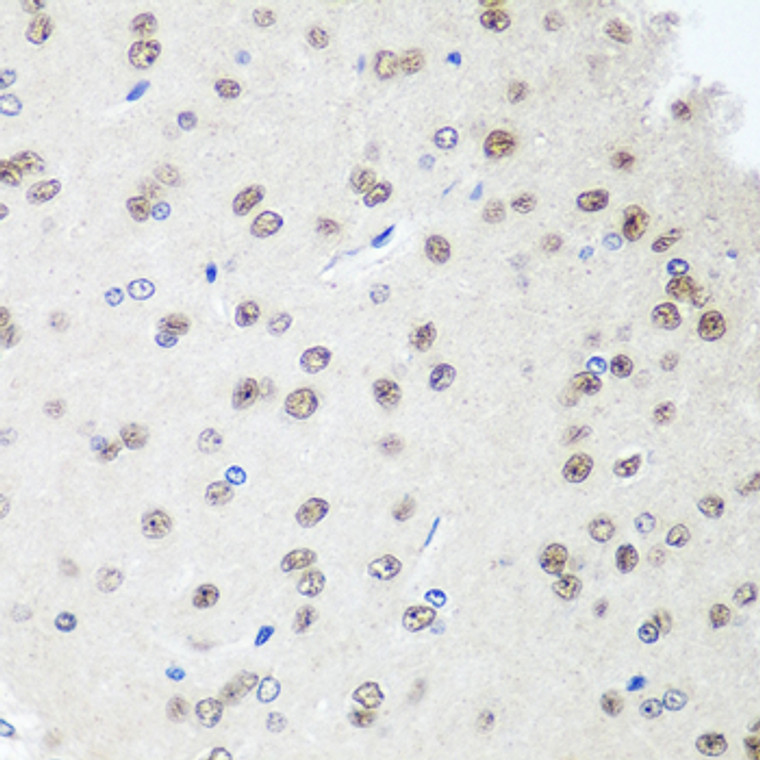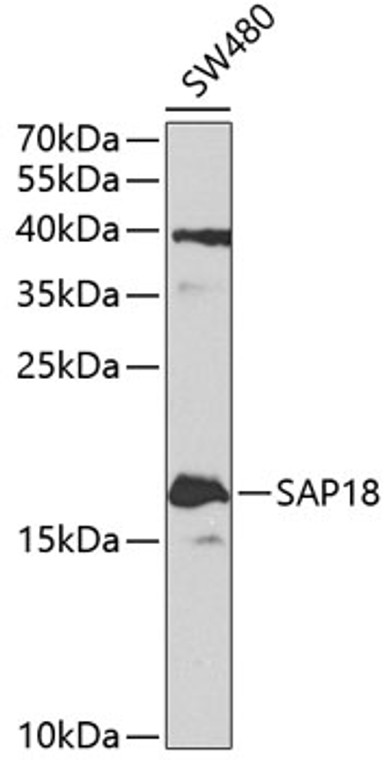| Host: |
Rabbit |
| Applications: |
WB/IHC |
| Reactivity: |
Human/Mouse/Rat |
| Note: |
STRICTLY FOR FURTHER SCIENTIFIC RESEARCH USE ONLY (RUO). MUST NOT TO BE USED IN DIAGNOSTIC OR THERAPEUTIC APPLICATIONS. |
| Short Description: |
Rabbit polyclonal antibody anti-SAP18 (21-172) is suitable for use in Western Blot and Immunohistochemistry research applications. |
| Clonality: |
Polyclonal |
| Conjugation: |
Unconjugated |
| Isotype: |
IgG |
| Formulation: |
PBS with 0.02% Sodium Azide, 50% Glycerol, pH7.3. |
| Purification: |
Affinity purification |
| Dilution Range: |
WB 1:200-1:2000IHC-P 1:50-1:200 |
| Storage Instruction: |
Store at-20°C for up to 1 year from the date of receipt, and avoid repeat freeze-thaw cycles. |
| Gene Symbol: |
SAP18 |
| Gene ID: |
10284 |
| Uniprot ID: |
SAP18_HUMAN |
| Immunogen Region: |
21-172 |
| Immunogen: |
Recombinant fusion protein containing a sequence corresponding to amino acids 21-172 of human SAP18 (NP_005861.2). |
| Immunogen Sequence: |
AVESRVTQEEIKKEPEKPID REKTCPLLLRVFTTNNGRHH RMDEFSRGNVPSSELQIYTW MDATLKELTSLVKEVYPEAR KKGTHFNFAIVFTDVKRPGY RVKEIGSTMSGRKGTDDSMT LQSQKFQIGDYLDIAITPPN RAPPPSGRMRPY |
| Tissue Specificity | Ubiquitous. |
| Function | Component of the SIN3-repressing complex. Enhances the ability of SIN3-HDAC1-mediated transcriptional repression. When tethered to the promoter, it can direct the formation of a repressive complex to core histone proteins. Auxiliary component of the splicing-dependent multiprotein exon junction complex (EJC) deposited at splice junction on mRNAs. The EJC is a dynamic structure consisting of core proteins and several peripheral nuclear and cytoplasmic associated factors that join the complex only transiently either during EJC assembly or during subsequent mRNA metabolism. Component of the ASAP and PSAP complexes which bind RNA in a sequence-independent manner and are proposed to be recruited to the EJC prior to or during the splicing process and to regulate specific excision of introns in specific transcription subsets. The ASAP complex can inhibit mRNA processing during in vitro splicing reactions. The ASAP complex promotes apoptosis and is disassembled after induction of apoptosis. Involved in the splicing modulation of BCL2L1/Bcl-X (and probably other apoptotic genes).specifically inhibits the formation of proapoptotic isoforms such as Bcl-X(S).the activity is different from the established EJC assembly and function. |
| Protein Name | Histone Deacetylase Complex Subunit Sap1818 Kda Sin3-Associated Polypeptide2hor0202Cell Growth-Inhibiting Gene 38 ProteinSin3-Associated Polypeptide P18 |
| Database Links | Reactome: R-HSA-3214815Reactome: R-HSA-427413Reactome: R-HSA-72163Reactome: R-HSA-9679191 |
| Cellular Localisation | NucleusCytoplasmNucleus SpeckleShuttles Between The Nucleus And The CytoplasmColocalizes With Acin1 And Srsf2 In Nuclear Speckles |
| Alternative Antibody Names | Anti-Histone Deacetylase Complex Subunit Sap18 antibodyAnti-18 Kda Sin3-Associated Polypeptide antibodyAnti-2hor0202 antibodyAnti-Cell Growth-Inhibiting Gene 38 Protein antibodyAnti-Sin3-Associated Polypeptide P18 antibodyAnti-SAP18 antibodyAnti-GIG38 antibody |
Information sourced from Uniprot.org
12 months for antibodies. 6 months for ELISA Kits. Please see website T&Cs for further guidance









